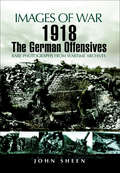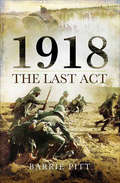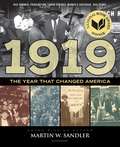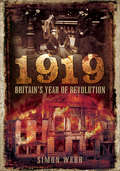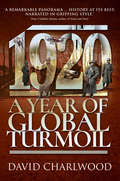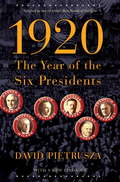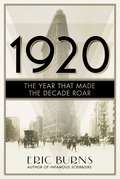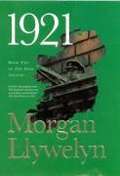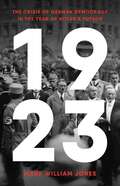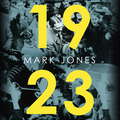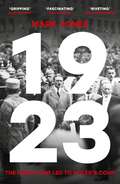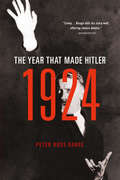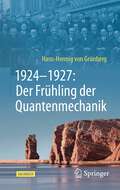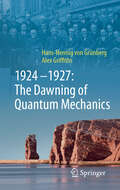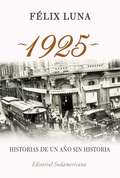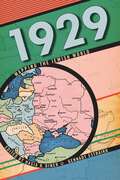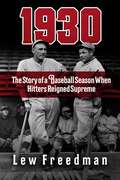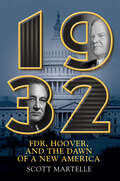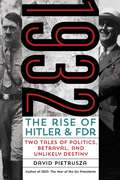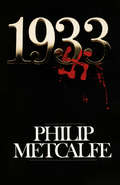- Table View
- List View
1918: The German Offensives (Images of War)
by John Sheen&“Serves to illustrate the carnage of battle throughout the three critical months of 1918: March, April and May . . . An amazing archive.&”—The Great War Magazine In March 1918 the German Army launched a series of offensives that brought them very close to winning the war. Military photographers followed their advance and took many photographs of the operations as they progressed. This is the war seen from the German perspective, British and French soldiers lie dead on the battlefield, and Allied prisoners are escorted to the rear, as the German Artillery pound away covering the advance of the &“Feldgrau.&” These photographs are seldom seen in books dealing with the allied point of view. Many scarce and rare photographs show the carnage of battle throughout March, April and May 1918. The author has also included group photographs of some of the units involved, as well as memorial cards of individuals who fell or died of wounds. This book will be a useful reference to anyone with an interest in the German Army during the First World War. &“Provides a good close up look at soldiers, guns, shells, small arms and other points of interest.&”—Over the Front &“It is like watching a well-made documentary unfold before your eyes . . . The whole book is a superb piece of work, highly recommended.&”—Destructive Music &“Particularly atmospheric . . . This is an unusual and welcome selection of illustrations.&”—Military Illustrated
1918: The German Offensives (Images of War)
by John Sheen&“Serves to illustrate the carnage of battle throughout the three critical months of 1918: March, April and May . . . An amazing archive.&”—The Great War Magazine In March 1918 the German Army launched a series of offensives that brought them very close to winning the war. Military photographers followed their advance and took many photographs of the operations as they progressed. This is the war seen from the German perspective, British and French soldiers lie dead on the battlefield, and Allied prisoners are escorted to the rear, as the German Artillery pound away covering the advance of the &“Feldgrau.&” These photographs are seldom seen in books dealing with the allied point of view. Many scarce and rare photographs show the carnage of battle throughout March, April and May 1918. The author has also included group photographs of some of the units involved, as well as memorial cards of individuals who fell or died of wounds. This book will be a useful reference to anyone with an interest in the German Army during the First World War. &“Provides a good close up look at soldiers, guns, shells, small arms and other points of interest.&”—Over the Front &“It is like watching a well-made documentary unfold before your eyes . . . The whole book is a superb piece of work, highly recommended.&”—Destructive Music &“Particularly atmospheric . . . This is an unusual and welcome selection of illustrations.&”—Military Illustrated
1918: The Last Act (Pen and Sword Military Classics)
by Barrie PittThis vividly detailed history examines the battles and politics in the final year of WWI—includes trench diagrams, photographs, and maps of battles. Three years into the Great War, Europe found itself in a stalemate on the Western Front. The Russian Front had collapsed and the United States had abandoned neutrality, joining the Allied cause. These developments set the stage for the climactic events of 1918, the year that would finally see an end to the war. In 1918: The Last Act, acclaimed military historian Barrie Pitt &“analyses with great lucidity the broad outlines of German and Allied Strategy&” (The Sunday Telegraph). With an expert eye, Pitt looks into the policies of the warring powers, the men who led them, and the resulting battles along the Western Front. From the German onslaught of March 21, 1918, to the struggles in Champagne and the Second Battle of the Marne, to the turning point in August and the final, hard-won victory, 1918 The Last Act traces &“the blunders at the top and the filth and stench and misery of the trenches&” in order to deliver &“a compelling narrative&” of World War I (Daily Mail).
1919 The Year That Changed America
by Martin Sandler1919 was a world-shaking year. America was recovering from World War I and black soldiers returned to racism so violent that that summer would become known as the Red Summer. The suffrage movement had a long-fought win when women gained the right to vote. Laborers took to the streets to protest working conditions; nationalistic fervor led to a communism scare; and temperance gained such traction that prohibition went into effect. Each of these movements reached a tipping point that year. Now, one hundred years later, these same social issues are more relevant than ever. Sandler traces the momentum and setbacks of these movements through this last century, showing that progress isn't always a straight line and offering a unique lens through which we can understand history and the change many still seek.
1919, The Year of Racial Violence
by David F. Krugler1919, The Year of Racial Violence recounts African Americans' brave stand against a cascade of mob attacks in the United States after World War I. The emerging New Negro identity, which prized unflinching resistance to second-class citizenship, further inspired veterans and their fellow black citizens. In city after city - Washington, DC; Chicago; Charleston; and elsewhere - black men and women took up arms to repel mobs that used lynching, assaults, and other forms of violence to protect white supremacy; yet, authorities blamed blacks for the violence, leading to mass arrests and misleading news coverage. Refusing to yield, African Americans sought accuracy and fairness in the courts of public opinion and the law. This is the first account of this three-front fight - in the streets, in the press, and in the courts - against mob violence during one of the worst years of racial conflict in US history.
1919: Britain's Year of Revolution
by Simon WebbThe little-known true story of rioting and rebellion among British veterans and workers after the end of World War I. On the August Bank Holiday of 1919, the government in London dispatched warships to the northern city of Liverpool in an overwhelming show of force. Thousands of troops, backed by tanks, had been trying without success to suppress disorder on the streets. Earlier that year in London, a thousand soldiers had marched on Downing Street before being disarmed by a battalion of the Grenadier Guards loyal to the government. In Luton that summer, the town hall was burned down by rioters before the army was brought in to restore order, and in Glasgow, artillery and tanks were positioned in the center of the city to deter what the secretary of state for Scotland described as a Bolshevik uprising. Industrial unrest and mutiny in the armed forces combined to produce the fear that Britain was facing, the same kind of situation which had led to the Russian Revolution two years earlier. Drawing chiefly upon contemporary sources, this book describes the sequence of events which looked as though they might be the precursor to a revolution along the lines of those sweeping across Europe at that time. To some observers, it seemed only a matter of time before Britain transformed itself from a constitutional monarchy into a Soviet Republic. &“An extraordinary tale.&” —Battlefield
1920: A Year of Global Turmoil
by David Charlwood“History writing at its best . . . teasing out extraordinary parallels between our current world and that of a century ago.” —Tim Butcher, author of Blood RiverA pandemic has killed millions. Violent uprisings are tearing apart the Middle East. Nationalism is on the march in Europe. An unlikely candidate is running for president in the US on a populist platform to put “America first.” The year is 1920. 1920: A Year of Global Turmoil tells the story of twelve months that set in motion one hundred years of history. From America to Asia, the events of 1920 foreshadowed the decline of empires, the coming of another global conflict, and the rise of an American president who would change his country's relationship with the world. Weaving personal accounts with grand narrative, it vividly illuminates a past that echoes the present.
1920: The Year of the Six Presidents
by David PietruszaThe presidential election of 1920 was among history’s most dramatic. Six once-and-future presidents-Wilson, Harding, Coolidge, Hoover, and Teddy and Franklin Roosevelt-jockeyed for the White House. With voters choosing between Wilson’s League of Nations and Harding’s front-porch isolationism, the 1920 election shaped modern America. Women won the vote. Republicans outspent Democrats by 4 to 1, as voters witnessed the first extensive newsreel coverage, modern campaign advertising, and results broadcast on radio. America had become an urban nation: Automobiles, mass production, chain stores, and easy credit transformed the economy. 1920 paints a vivid portrait of America, beset by the Red Scare, jailed dissidents, Prohibition, smoke-filled rooms, bomb-throwing terrorists, and the Klan, gingerly crossing modernity’s threshold.
1920: The Year that Made the Decade Roar
by Eric BurnsOne of the most dynamic eras in American history--the 1920s--began with this watershed year that would set the tone for the century to follow. "The Roaring Twenties" is the only decade in American history with a widely applied nickname, and our collective fascination with this era continues. But how did this surge of innovation and cultural milestones emerge out of the ashes of The Great War? No one has yet written a book about the decade's beginning. Acclaimed author Eric Burns investigates the year of 1920, which was not only a crucial twelve-month period of its own, but one that foretold the future, foreshadowing the rest of the 20th century and the early years of the 21st, whether it was Sacco and Vanzetti or the stock market crash that brought this era to a close. Burns sets the record straight about this most misunderstood and iconic of periods. Despite being the first full year of armistice, 1920 was not, in fact, a peaceful time--it contained the greatest act of terrorism in American history to date. And while 1920 is thought of as starting a prosperous era, for most people, life had never been more unaffordable. Meanwhile, African Americans were putting their stamp on culture and though people today imagine the frivolous image of the flapper dancing the night away, the truth was that a new kind of power had been bestowed on women, and it had nothing to do with the dance floor. . . From prohibition to immigration, the birth of jazz, the rise of expatriate literature, and the original Ponzi scheme, 1920 was truly a year like no other.
1921 The Great Novel of the Irish Civil War
by Morgan LlywelynNovel about the beginning of Irish independence from England, and the subsequent civil war, seen through the eyes of a fictional journalist. Some violence.
1922
by Jean-Michel Rabaté1922: Literature, Culture, Politics examines key aspects of culture and history in 1922, a year made famous by the publication of several modernist masterpieces, such as T. S. Eliot's The Waste Land and James Joyce's Ulysses. Individual chapters written by leading scholars offer new contexts for the year's significant works of art, philosophy, politics, and literature. 1922 also analyzes both the political and intellectual forces that shaped the cultural interactions of that privileged moment. Although this volume takes post-World War I Europe as its chief focus, American artists and authors also receive thoughtful consideration. In its multiplicity of views, 1922 challenges misconceptions about the 'Lost Generation' of cultural pilgrims who flocked to Paris and Berlin in the 1920s, thus stressing the wider influence of that momentous year.
1923: The Crisis of German Democracy in the Year of Hitler's Putsch
by Mark William JonesHow Germany&’s fledgling democracy nearly collapsed in 1923—and how pro-democracy forces fought back In 1923, the Weimar Republic faced a series of crises, including foreign occupation of its industrial heartland, rampant inflation, radical violence, and finally Hitler&’s infamous &“beer hall putsch.&” Fanning the flames of anti-government and anti-Semitic sentiment, the Nazis tried to violently seize power in Munich, only failing after they were abandoned by like-minded conservatives. In 1923, historian Mark William Jones draws on new research to offer a revealing portrait of German politics and society in this turbulent year. Tracing Hitler&’s early rise, Jones reveals how political pragmatism and unprecedented international cooperation with the West brought Germany out of its crisis year. Although Germany would succumb to tyranny a decade later, the story of the republic&’s survival in 1923 offers essential lessons to anyone concerned about the future of democracy today.
1923: The Forgotten Crisis in the Year of Hitler’s Coup
by Mark JonesThe astonishing year when German democracy faced crisis and near destruction.1923 was one of the most remarkable years of modern European history. In January, France and Belgium militarily occupied Germany's economic heartland, the Ruhr; triggering a series of crises that almost spiralled out of control. Hyperinflation plunged millions into poverty. The search for scapegoats empowered political extremes. Hitler's populism ascended to national prominence. Communists, Nazis, separatists all thought that they could use the crises to destroy democracy. None succeeded. 1923 was the year of Hitler's first victory - and his first defeat. Fanning the flames of instability, anti-government and antisemitic sentiment, the Nazis abortive yet pivotal putsch in a Munich beer hall failed when they were abandoned by their likeminded conservative allies. Drawing on previously unseen sources, Mark Jones weaves together a thrilling and resonant narrative of German lives in this turbulent time. Tracing Hitler's rise, we see how political pragmatism and international cooperation eventually steered the nation away from total insurrection. A decade later, when Weimar democracy eventually succumbed to tyranny, the warnings from 1923 - rising of nationalist rhetoric, fragile European consensus, and underestimation the of the enemies of liberalism - became only too apparent.This account of the republic's convulsions and survival offer a gripping image of a modern society in extreme crisis.
1923: The Forgotten Crisis in the Year of Hitler’s Coup
by Mark Jones'Gripping . . . thoroughly researched and beautifully written . . . a warning for our times' Alex Watson, author of Ring of Steel'Fascinating . . . shows powerfully that there was nothing inevitable about the survival of Germany's young democracy in that year - nor about its death a decade later. A timely reminder' Katja Hoyer, author of Beyond the WallThe astonishing year when German democracy faced crisis and near destruction.1923 was one of the most remarkable years of modern European history. In January, France and Belgium militarily occupied Germany's economic heartland, the Ruhr; triggering a series of crises that almost spiralled out of control. Hyperinflation plunged millions into poverty. The search for scapegoats empowered political extremes. Hitler's populism ascended to national prominence. Communists, Nazis, separatists all thought that they could use the crises to destroy democracy. None succeeded. 1923 was the year of Hitler's first victory - and his first defeat. Fanning the flames of instability, anti-government and antisemitic sentiment, the Nazis' abortive yet pivotal putsch in a Munich beer hall failed when they were abandoned by their likeminded conservative allies. Drawing on previously unseen sources, Mark Jones weaves together a thrilling and resonant narrative of German lives in this turbulent time. Tracing Hitler's rise, we see how political pragmatism and international cooperation eventually steered the nation away from total insurrection. A decade later, when Weimar democracy eventually succumbed to tyranny, the warnings from 1923 - rising of nationalist rhetoric, fragile European consensus, and underestimation the of the enemies of liberalism - became only too apparent.This account of the republic's convulsions and survival offers a gripping image of a modern society in extreme crisis.
1924: The Year That Made Hitler
by Peter Ross RangeThe dark story of Adolf Hitler's life in 1924--the year that made a monsterBefore Adolf Hitler's rise to power in Germany, there was 1924. This was the year of Hitler's final transformation into the self-proclaimed savior and infallible leader who would interpret and distort Germany's historical traditions to support his vision for the Third Reich. Everything that would come--the rallies and riots, the single-minded deployment of a catastrophically evil idea--all of it crystallized in one defining year. 1924 was the year that Hitler spent locked away from society, in prison and surrounded by co-conspirators of the failed Beer Hall Putsch. It was a year of deep reading and intensive writing, a year of courtroom speeches and a treason trial, a year of slowly walking gravel paths and spouting ideology while working feverishly on the book that became his manifesto: Mein Kampf.Until now, no one has fully examined this single and pivotal period of Hitler's life. In 1924, Peter Ross Range richly depicts the stories and scenes of a year vital to understanding the man and the brutality he wrought in a war that changed the world forever.
1924–1927: Der Frühling der Quantenmechanik
by Hans-Hennig von GrünbergSeines Heuschnupfens wegen verbrachte Werner Heisenberg im Juni 1925, vor nun bald hundert Jahren, zehn Tage auf der Insel Helgoland, wo er einen Artikel schrieb, der als der Beginn der Geschichte der modernen Quantentheorie angesehen werden kann. Im Oktober 1927 fand die fünfte Solvay-Konferenz in Brüssel statt, die wohl berühmteste Konferenz in der Geschichte der Physik, und brachte die spannende Entstehungsgeschichte der Quantenmechanik zu ihrem vorläufigen Ende. In diesen Jahren zwischen 1925 und 1927 entwickelten acht Physiker aus fünf Ländern eine Theorie, die das physikalische Verständnis unserer Welt radikal verändert sollte. Mit diesem Buch wandert man vom September 1924 bis zum Oktober 1927 durch die Zeit und erfährt dabei in Form von Monatsberichten, wie die Quantenmechanik entstanden ist, was die handelnden Personen erlebt und gedacht, in welcher Zeit sie gelebt haben und wie aus dem Zusammenspiel Einzelner langsam das gemeinsame Ganze entstanden ist. Das Buch wendet sich an Laien, die sich von der Quantenmechanik faszinieren lassen wollen und dabei verstehen werden, dass diese Theorie wie Anita Berber, der Jazz oder die Erfindung des Fernsehens ein typisches Kind der 1920er Jahre ist.
1924–1927: The Dawning of Quantum Mechanics
by Hans-Hennig von Grünberg Alex GriffithsIn June of 1925, almost a hundred years ago, Werner Heisenberg spent ten days on the island of Heligoland - thanks to his hayfever. This respite afforded him the time to write an article that would mark the beginning of the history of modern quantum theory. Two years later, in October of 1927, the fifth Solvay Conference, arguably the most famous gathering in the history of physics, took place in Brussels, bringing the riveting story of the origins of quantum mechanics to a close. During this crucial and relatively short period between 1925 and 1927, eight physicists from five countries developed a theory that would radically change the physical understanding of our world and would become the basis for almost all advanced technologies: transistors, lasers, light-emitting diodes, medical imaging, the electron microscope and much more. The reader will travel through time from September 1924 to October 1927 and learn by way of monthly entries how quantum mechanics came into being, what the people involved experienced and thought in the context of the time they lived in, and how a unified whole slowly emerged from the interactions of these individuals. The book is aimed at laypeople who are fascinated by quantum mechanics and its history. They will learn that this theory, like Anita Berber, jazz or the invention of television, is a characteristic child of the 1920s.
1925. HISTORIA DE UN AÑO SIN... (EBOOK)
by Felix Luna1925, un año sin mayor significación, es celebrado por Félix Luna en este libro diferente a los que integran su vasta obra. Se trata de diálogos entre gente muy diversa, en los que convergen los temas que en ese momento apasionaban a los argentinos. Qué motivo llevó al conocido historiador a tejer este ejercicio de imaginación? Lo confiesa en el prólogo. Pero aunque no lo hiciera, 1925 es un deleite para la lectura por la variedad de personajes que aparecen en estas páginas y por la brecha que se define entre ese momento histórico -relativamente cercano- y el mundo de hoy, a través de una vida, la del autor.
1925. Historias de un año sin historia
by Felix LunaA través de diálogos entre gente muy diversa, se revelan los temas queen ese momento apasionaban a los argentinos. 1925, un año sin mayor significación, es celebrado por Félix Luna eneste libro diferente a los que integran su vasta obra. «1925» es undeleite para la lectura por los diversos personajes, lo variopinto delos lenguajes usados, el colorido de la temática desplegaday por la brecha que se define entre ese momento histórico -relativamentecercano- y el mundo de hoy, a través de una vida, la del autor.
1929: Mapping the Jewish World (Alternative Criminology #13)
by Gennady Estraikh Hasia R DinerWinner of the 2013 National Jewish Book Award, Anthologies and CollectionsThe year 1929 represents a major turning point in interwar Jewish society, proving to be a year when Jews, regardless of where they lived, saw themselves affected by developments that took place around the world, as the crises endured by other Jews became part of the transnational Jewish consciousness. In the United States, the stock market crash brought lasting economic, social, and ideological changes to the Jewish community and limited its ability to support humanitarian and nationalist projects in other countries. In Palestine, the anti-Jewish riots in Hebron and other towns underscored the vulnerability of the Zionist enterprise and ignited heated discussions among various Jewish political groups about the wisdom of establishing a Jewish state on its historical site. At the same time, in the Soviet Union, the consolidation of power in the hands of Stalin created a much more dogmatic climate in the international Communist movement, including its Jewish branches. Featuring a sparkling array of scholars of Jewish history, 1929 surveys the Jewish world in one year offering clear examples of the transnational connections which linked Jews to each other—from politics, diplomacy, and philanthropy to literature, culture, and the fate of Yiddish—regardless of where they lived. Taken together, the essays in 1929 argue that, whether American, Soviet, German, Polish, or Palestinian, Jews throughout the world lived in a global context.
1930: The Story of a Baseball Season When Hitters Reigned Supreme
by Lew FreedmanThe 1930 Major League baseball season was both marvelous and horrendous, great for hitters, embarrassing for pitchers. In totality it was just this side of insane as an outlier among all seasons.Major League Baseball began with the founding of the National League in 1876. In the 145 seasons since then, one season stands out as unique for the astounding nature of hitting: 1930.A flipside of 1968&’s &“Year of the Pitcher,&” when the great St. Louis Cardinals Bob Gibson compiled a 1.12 earned run average and Detroit Tigers Denny McLain won 31 games, the 1930 season was when the batters reigned supreme. During this incredible season, more than one hundred players batted .300, the entire National League averaged .300, ten players hit 30 or more home runs, and some of the greatest individual performances established all-time records. From New York Giants Bill Terry&’s .401 average—the last National Leaguer to hit over .400—to the NL-record 56 home runs and major league–record 192 runs batted in by Chicago Cubs Hack Wilson, the 1930 season is a wild, sometimes unbelievable, often wacky baseball story.Breaking down the anomaly of the season and how each team fared, veteran journalist Lew Freeman tells the story of a one-off year unlike any other. While the greats stayed great, and though some pitchers did hold their own—with seven winning 20 or more games, including 28 by Philadelphia Athletics&’ Lefty Grove and 25 by Cleveland Indians&’ Wes Ferrell—Freedman shares anecdotes about those players that excelled in 1930, and only 1930. More than ninety years later, 1930 offers insight into a season that still stands the test of time for batting excellence.
1931 Desh ya Prem?: १९३१ देश या प्रेम?
by Satya Vyas1931 देश या प्रेम एक रोमांचक ऐतिहासिक पुस्तक है जो 20वीं सदी के शुरुआती भारतीय स्वतंत्रता आंदोलन के दौरान घटित घटनाओं पर आधारित है। यह सत्य व्यास द्वारा लिखित कृति क्रांतिकारी नेताओं के जीवन, भावनाओं, और समाज पर उनके प्रभाव को दर्शाती है, जिसमें गांधीजी का नमक सत्याग्रह और भगत सिंह व उनके साथियों की शहादत के घटनाक्रम शामिल हैं। पुस्तक क्रांति के मानवीय पहलू को उजागर करती है, नायकों की मानसिक, सामाजिक और पारिवारिक परिस्थितियों पर ध्यान केंद्रित करती है, और भारतीय इतिहास तथा स्वतंत्रता आंदोलन के कम ज्ञात किस्सों में रुचि रखने वाले किसी भी व्यक्ति के लिए एक अनिवार्य पठन है।
1932: FDR, Hoover, and the Dawn of a New America
by Scott MartelleA fascinating behind-the-scenes look at a year in American history that still resonates today, 1932: FDR, Hoover, and the Dawn of a New America tells the story of a battered nation fighting for its own future amid the depths of the Great Depression. At the start of 1932, the nation&’s worst economic crisis has left one-in-four workers without a job, countless families facing eviction, banks shutting down as desperate depositors withdraw their savings, and growing social and political unrest from urban centers to the traditionally conservative rural heart of the country. Amid this turmoil, a political decision looms that will determine the course of the nation. It is a choice between two men with very diferent visions of America: Incumbent Republican Herbert Hoover with his dogmatic embrace of small government and a largely unfettered free market, and New York&’s Democratic Governor Franklin Delano Roosevelt and his belief that the path out of the economic crisis requires government intervention in the economy and a national sense of shared purpose. Now veteran journalist Scott Martelle provides a gripping narrative retelling of that vitally significant year as social and political systems struggled under the weight of the devastating Dust Bowl, economic woes, rising political protests, and growing demand for the repeal of Prohibition. That November, voters overwhelmingly rejected decades of Republican rule and backed Roosevelt and his promise to redefine the role of the federal government while putting the needs of the people ahead of the wishes of the wealthy. Deftly told, this illuminating work spotlights parallel events from that pivotal year and brings to life figures who made headlines in their time but have been largly forgotten today. Ultimately, it is the story of a nation that, with the help of a leader determined to unite and inspire, took giant steps toward a new America.
1932: The Rise of Hitler and FDR--Two Tales of Politics, Betrayal, and Unlikely Destiny
by David PietruszaTwo Depression-battered nations confronted destiny in 1932, going to the polls in their own way to anoint new leaders, to rescue their people from starvation and hopelessness. America would elect a Congress and a president ebullient aristocrat Franklin Roosevelt or tarnished Wonder Boy Herbert Hoover. Decadent, divided Weimar Germany faced two rounds of bloody Reichstag elections and two presidential contests doddering reactionary Paul von Hindenburg against rising radical hate-monger Adolf Hitler. The outcome seemed foreordained unstoppable forces advancing upon crumbled, disoriented societies. A merciless Great Depression brought greater perhaps hopeful, perhaps deadly transformation: FDR s New Deal and Hitler s Third Reich. But neither outcome was inevitable. Readers enter the fray through David Pietrusza s page-turning account: Roosevelt s fellow Democrats may yet halt him at a deadlocked convention. 1928 s Democratic nominee, Al Smith, harbors a grudge against his one-time protege. Press baron William Randolph Hearst lays his own plans to block Roosevelt s ascent to the White House. FDR s politically-inspired juggling of a New York City scandal threatens his juggernaut. In Germany, the Nazis surge at the polls but twice fall short of Reichstag majorities. Hitler, tasting power after a lifetime of failure and obscurity, falls to Hindenburg for the presidency also twice within the year. Cabals and counter-cabals plot. Secrets of love and suicide haunt Hitler. Yet guile and ambition may yet still prevail. 1932 s breathtaking narrative covers two epic stories that possess haunting parallels to today s crisis-filled vortex. It is an all-too-human tale of scapegoats and panaceas, class warfare and racial politics, of a seemingly bottomless depression, of massive unemployment and hardship, of unprecedented public works/infrastructure programs, of business stimulus programs and damaging allegations of political cronyism, of waves of bank failures and of mortgages foreclosed, of Washington bonus marches and Berlin street fights, of once-solid financial empires collapsing seemingly overnight, of rapidly shifting social mores, and of mountains of irresponsible international debt threatening to crash not just mere nations but the entire global economy. It is the tale of spell-binding leaders versus bland businessmen and out-of-touch upper-class elites and of two nations inching to safety but lurching toward disaster. It is 1932 s nightmare with lessons for today. "
1933
by Philip Metcalfe"Using letters, diaries, and memoirs, Metcalfe distills the personalities, viewpoints, and day-to-day reactions of five alert and often directly involved witnesses to Hitler's consolidation of power. They are: U.S. Ambassador to Germany, William Dodd, and his high-spirited daughter, Martha; Bella Fromm, a glamorous German society columnist who was Jewish and made no secret of it; Ernest Hanfstaengl, Hitler's somewhat buffoonish foreign-press chief; and Rudolf Diels, the first head of the Gestapo." --Publishers Weekly
